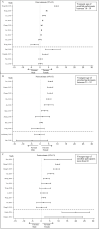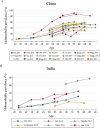Community prevalence and dyad disease pattern of multimorbidity in China and India: a systematic review
- PMID: 36113890
- PMCID: PMC9486196
- DOI: 10.1136/bmjgh-2022-008880
Community prevalence and dyad disease pattern of multimorbidity in China and India: a systematic review
Abstract
Background: Driven by the increasing life expectancy, China and India, the two most populous countries in the world are experiencing a rising burden of multimorbidity. This study aims to explore community prevalence and dyad patterns of multimorbidity in China and India.
Methods: We conducted a systematic review of five English and Chinese electronic databases. Studies involving adults 18 years or older at a community level, which reported multimorbidity prevalence and/or patterns were included. A modified Newcastle-Ottawa Scale was used for quality assessment. Despite large heterogeneity among reported studies, a systematic synthesis of the results was conducted to report the findings.
Results: From 13 996 studies retrieved, 59 studies met the inclusion criteria (46 in China, 9 in India and 4 in both). The median prevalence of multimorbidity was 30.7% (IQR 17.1, 49.4), ranging from 1.5% to 90.5%. There was a large difference in multimorbidity prevalence between China and India, with median prevalence being 36.1% (IQR 19.6, 48.8) and 28.3% (IQR 8.9, 56.8), respectively. Among 27 studies that reported age-specific prevalence, 19 studies found multimorbidity prevalence increased with age, while 8 studies observed a paradoxical reduction in the oldest age group. Of the 34 studies that reported sex-specific prevalence, 86% (n=32) observed a higher prevalence in females. The most common multimorbidity patterns from 14 studies included hypertensive diseases combined with diabetes mellitus, arthropathies, heart diseases and metabolic disorders. All included studies were rated as fair or poor quality.
Conclusion: Multimorbidity is highly prevalent in China and India with hypertensive diseases and other comorbidities being the most observed patterns. The overall quality of the studies was low and there was a lack of representative samples in most studies. Large epidemiology studies, using a common definition of multimorbidity and national representative samples, with sex disaggregation are needed in both countries.
Prospero registration number: CRD42020176774.
Keywords: arthritis; epidemiology; hypertension; public health; systematic review.
© Author(s) (or their employer(s)) 2022. Re-use permitted under CC BY-NC. No commercial re-use. See rights and permissions. Published by BMJ.
Conflict of interest statement
Competing interests: None declared.
Figures




References
-
- van den Akker M, Buntinx F, Knottnerus J. Comorbidity or multimorbidity what’s in a name? A review of literature. Europ J Gen Pract 1996;2:65–70.
Publication types
MeSH terms
LinkOut - more resources
Full Text Sources
Medical
Miscellaneous
